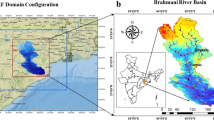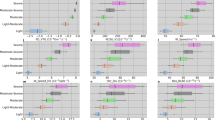Accurate prediction of movement and intensity of tropical cyclone is still most challenging problem in numerical weather prediction. The positive progress in this field can be achieved by providing network of observations in the storm region and best representation of atmospheric physical processes in the model. In the present study later part was attempted to investigate the sensitivity of movement and intensity of the severe cyclonic storm AILA to different physical processes in the Weather Research and Forecasting model. Three sets of experiments were conducted for convection, microphysics (MP) and planetary boundary layer (PBL) processes. Model-simulated fields like minimum central surface pressure, maximum surface wind, track and vector displacement error are considered to test the sensitivity. The results indicate that the movement of the system is more sensitive to the cumulus physics and the intensity of the cyclone is sensitive to both PBL and cumulus physics. The combination of Betts Miller Janjic (BMJ) for convection, Yonsei University (YSU) for PBL and Purdue Lin (LIN) for microphysics is found to perform better than other combination schemes. The horizontal and vertical features of the system along with its special features like complete northward movement of the system throughout the travel period and the consistent cyclonic storm intensity until 15 hrs after the landfall could be well simulated by the model.








Similar content being viewed by others
References
Anthes R A and Hoke J A 1975 The effect of horizontal divergence and the latitudinal variation of the coriolis parameter on drift of a model hurricane; Mon. Weather Rev. 103 757–763.
ARW Version 3 modeling system user’s guide, April 2012, Meso scale & Microscale Meteorological Division, NCAR.
Betts A K and Miller M J 1986 A new convective adjustment scheme. Part II: Single column test using GATE wave, BOMEX, ATEX, and Arctic air mass data sets; Quat. J. Roy. Meteorol. Soc. 112 693–709.
Bhaskar Rao D V 1997 Tropical simulation with Emanuel’s convection scheme; Mausam 48 113–112.
Bhaskar Rao D V and Hari Prasad D 2007 Sensitivity of tropical cyclone intensification to boundary layer and convective processes; Nat. Hazards 41 429–445.
Ferrier B S, Jin Y, Lin Y, Black T, Rogers E and DiMego G 2002 Implementation of a new grid-scale cloud and precipitation scheme in the NCEP Eta model; Preprints, 15th Conf. on NWP, San Antonio, Am. Meteorol. Soc., pp. 280–283.
Gayatri Vani D, Rambabu S, Rajasekhar M, Rama G V, Apparao B V and Ghosh A K 2011 Analysis of MM5 predictions at Sriharikota during north east monsoon 2008; J. Earth Syst. Sci. 120 755–771.
Gilland E K and Rowe C M 2007 A comparison of cumulus parameterization schemes in the WRF model; 21st Conference on Hydrology.
Gray W M 1968 Global view of the origin of the tropical disturbance and storms; Mon. Weather Rev. 96 669–700.
Grell G A and Devenyi D 2002 A generalized approach to parameterizing convection combining ensemble and data assimilation techniques; Geophys. Res. Lett. 29 38-1–4.
Holland G J 1980 An analysis model of the wind and pressure profiles in hurricanes; Mon. Weather Rev. 108 1212–1218.
Holland G J (ed.) 1993 The global guide to tropical cyclone forecasting WMO/TD-560; World Meteorological Organization, Geneva, 342p.
Hong S-Y and Lim J-O J 2006 The WRF Single-Moment 6-Class Microphysics Scheme (WSM6); J. Korean Meteorol. Soc. 42 129–151.
Hong S Y, Noh Y and Dudhia J 2006 A new vertical diffusion package with an explicit treatment of entrainment processes; Mon. Weather Rev. 121 589–603.
Janjic Z I 1994 The step-mountain eta coordinate model: Further development of convection, viscous sublayer and turbulence closure schemes; Mon. Weather Rev. 122 927–945.
Janjic Z I 2000 Comments on ‘Development and evaluation of convection scheme for use in climate models’; J. Atmos. Sci. 57 3686.
Kain J S 2004 The Kain–Fritsch convection parameterization: An update; J. Appl. Meteorol. 43 170–181.
Kain J S and Fritsch J M 1993 Convective parameterization for mesoscale models: The Kain–Fritsch scheme. The representation of cumulus convection in numerical models; Meteorol. Monogr. Am. Meteorol. Soc. 46 165–170.
Kasahara A 1961 A numerical experiment on the development of a tropical cyclone; J. Meteorol. 18 259–282.
Kessler E 1969 On the distribution and continuity of water substances in atmospheric circulation; Meteorol. Monogr. 32 84.
Kishtawal C M, Deb S K, Pal P K and Joshi P C 2009 Estimation of atmospheric motion vectors from Kalpana-1 imagers; J. Appl. Meteorol. Climatol. 48 2410–2421.
Kuo H L 1965 On the formation and intensification of tropical cyclones through latent heat release by cumulus convection; J. Atmos. Sci. 22 40–63.
Lin Y-L, Farley R D and Orville H D 1983 Bulk parameterization of the snow field in a cloud model; J. Climate. Appl. Meteorol. 22 1065–1092.
Mohanty U C, Mandal M and Raman S 2004 Simulation of Orissa super cyclone (1999) using PSU/NCAR mesoscale model; Nat. Hazards 31 373–390.
Nakanishi M and Niino H 2004 An improved Mellor-Yamada level 3 model with condensation physics: Its design and verification; Bound. Layer Meteorol. 112 1–31.
Ogura Y 1964 Frictionally controlled, thermally driven circulation in a circular vortex with application to tropical cyclones; J. Atmos. Sci. 21 610–621.
Pattanayak S and Mohanty U C 2008 A comparative study on performance of MM5 & WRF models in simulation of tropical cyclone over Bay of Bengal; Nat. Hazards 31 391–414.
Pleim J E 2007 A combined local and non-local closure model for the atmospheric boundary layer. Part: Model description and testing; J. Appl. Meteorol. Climatol. 46 1383–1395.
Skamarock W C, Klemp J B, Dudhia J, Gill D O, Barker D M, Duda M G, Huang X-Y, Wei-Wang and Powers J G 2008 A description of the Advanced Research WRF, NCAR technical note.
Sukoriansky S, Galperi B and Perov V 2006 A quasi-normal scale elimination model of turbulence and its application to stably stratified flows; Nonlinear Process. Geophys. 13 9–22.
Thompson G, Rasmussen R M and Manning K 2004 Explicit forecasts of winter precipitation using an improved bulk microphysics scheme. Part I: Description and sensitivity analysis; Mon. Weather Rev. 132 519–542.
Acknowledgements
The authors are thankful to ISRO authorities for allowing them to carry out research under Prediction of Regional Weather with Observational Meso-Network and Atmospheric Modelling (PRWONAM) project. The satellite derived winds and Automatic Weather Station data provided by MOSDAC, SAC and the radiosonde data provided by University of Wyoming are also acknowledged. They authors also owe thanks to India Meteorological Department for providing the observational data sets during the cyclone. The precipitation estimates provided by TRMM is highly acknowledged. They thank the anonymous reviewers, whose suggestions have resulted in substantial improvement of the paper.
Author information
Authors and Affiliations
Corresponding author
Rights and permissions
About this article
Cite this article
RAMBABU, S., GAYATRI VANI, D., RAMAKRISHNA, S.S.V.S. et al. Sensitivity of movement and intensity of severe cyclone AILA to the physical processes. J Earth Syst Sci 122, 979–990 (2013). https://doi.org/10.1007/s12040-013-0319-6
Received:
Revised:
Accepted:
Published:
Issue Date:
DOI: https://doi.org/10.1007/s12040-013-0319-6




